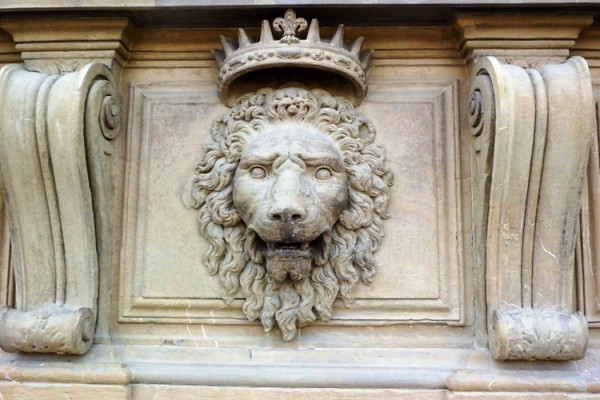Mascaron. History, features. 3D stl models for creating mascarons

Mascaron is an interesting architectural element. It is used both in interiors and exteriors.
From a purely architectural element it gradually turned into a simply decorative one. Today, mascarons can be found not only on the facades of ancient houses and buildings, but also in the decoration of premises. They can be decorated with wooden carved furniture, walls, interior or entrance doors.
On our website you can buy models for the further production of masks, animal faces and mascarons of various types and sizes.
In this article we will tell you a little more about this decorative element, its features, origin, history of mascarons, their use today, production on CNC machines using 3D models presented on our website.
If you still have questions, you can always ask our specialists by contacting us in any way convenient for you.
O mascaron, history:
Mascaron is a type of decor of a semi-sculptural type (bas-relief or high relief - the difference is only in the degree of protrusion, bas-relief is more smoothed, and high relief protrudes strongly above the main canvas). Most often it depicts a head - the face of a person, or a mythical creature, the face of an animal or a mask.
Mascarons originally appeared in Ancient Greece and their main purpose was not decoration at all, but intimidation. The first mascarons depicted the heads of gargoyles and their task was to protect wells, houses, bridges, both from evil spirits and sometimes from real people.
Then mascarons began to appear on buildings. And besides the terrifying appearance, others appeared, for example, comic, romantic, images of gods and goddesses.
Subsequently, mascarons remained a significant decorative element in Europe and many countries around the world for a long time. They often became decorations for door handles, house fences, bridge railings, arches, and so on.
Of course, over time they changed their appearance and design, depending on fashion and popular cultural trends. In Baroque times, they were richly decorated with floral decorations; in Rococo times, mascarons began to predominate, distinguished by their grace and aesthetics.
This art received a new significant turn during the heyday of classicism and neo-Renaissance, in the 18-19 centuries.
Including in Russia. With the light hand of Peter I, Petersburg turned into an almost European city of those years, with a huge number of architectural structures in the Baroque style that have survived to this day. Later, during the heyday of classicism, mascarons continued to appear in both St. Petersburg and Moscow. Until now, you can find many buildings there decorated with mascarons with theatrical masks, with the faces of gods and heroes, with the faces of lions. On the facades of houses, on bridges, on garden fences.
Kinds:
Mascaron can be divided into several key types:
- Animals (for example, the faces of lions - as one of the most popular subjects),
- Ancient Greek gods (for example, a mascaron with an image of Neptune was often placed on fountains, and water could flow directly from the mouth of a stone statue) and muses (for example, the muse of the tragedy Melpomene),
- Cupids,
- The faces of abstract boys, girls,
- Frightening masks depicting gargoyles and other mythological characters,
- Mascarons-grotesques and mascarons-emotions, popular in the Baroque era, often have bizarre faces, strange shapes, with bulging eyes and a crooked mouth. Such mascarons were needed to amuse the nobility.
- And many others.
- It is interesting that in our time mascarons may be completely unrelated to ancient Greek art and the classical style.
Today you can find completely different types of mascarons. For example: mascarons depicting movie characters, cartoons, book and comic book characters. This modern interpretation can take place in some bold, unusual interiors. You can buy models of such mascarons or order their production on our website.
Mascaron in our time:
Today, mascarons are most often found in classical interiors, in neoclassical and baroque styles. Their main task is to add an interesting bright decorative element to ordinary pieces of furniture or doors, to introduce a special mood, the spirit of the classical era.
Today, mascarons are made on computer numerical control (CNC) machines. Moreover, they can be made separately, as a decorative overlay on furniture or doors. Either directly on the main panel of the door array or, for example, the door of a chest of drawers.
The machine repeats with high precision the decor specified by program control on the material. And management, in turn, is formed by the model. Thus, to obtain high-quality and beautiful mascarons today, it is important to initially have a suitable 3D model.
You can buy such models on our website. In the following sections:
- Animal masks and faces
- High reliefs and bas-reliefs, historical and religious
- Animals
- Angels
- And in others. See the entire range of the site.
- In addition, it is possible to produce custom models. To do this, contact our specialists in any way convenient for you (messengers, application form on the website, email, telephone) and leave youre terms of reference.
You may be interested in other articles on the site:
- Toy soldiers as a collectible. 3D models of soldiers.
- Buddhist deities and their types: 3d models
- Italian style furniture on CNC: models for manufacturing.
- High reliefs and bas-reliefs on CNC. Models.



